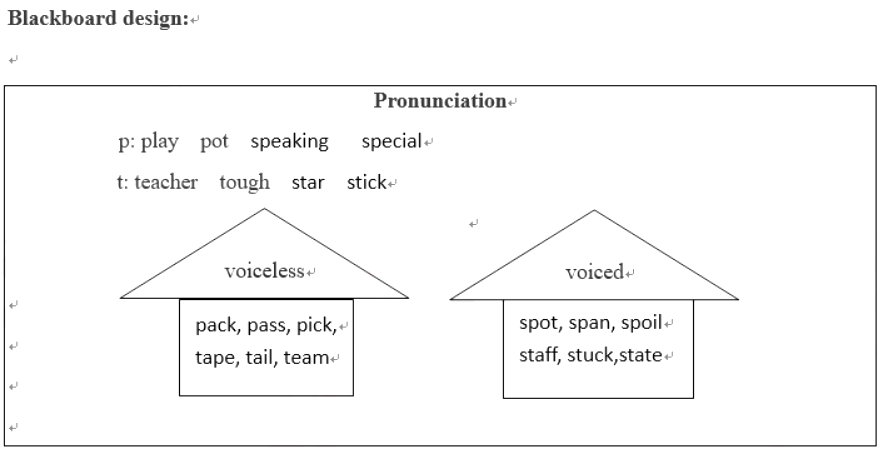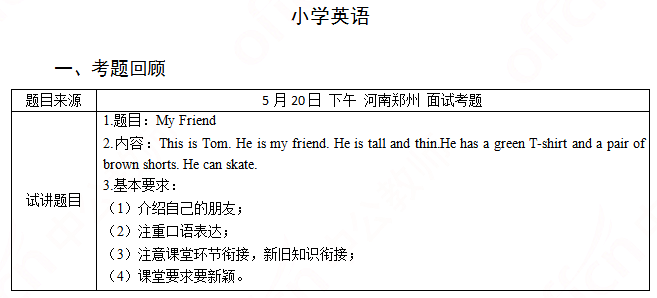what type of speaking tasks does the following activity belong to ? t: she reads english every morning. t: go to school. ss: she goes to school every morning. t: drive to work. ss: she drives to work every morning.():A. Controlled activity.B. Semi-control
题目
what type of speaking tasks does the following activity belong to ? t: she reads english every morning. t: go to school. ss: she goes to school every morning. t: drive to work. ss: she drives to work every morning.()
:A. Controlled activity.
B. Semi-controlled activity.
C. Role-play.
D. Information-gap activity.
相似考题
更多“what type of speaking tasks does the following activity belong to ? t: she reads engli ”相关问题
-
第1题:
4.—_________ Mike________ his homework in the evening?
—No,he doesn't.
A. Do;does
B. Does;do
C. Do;do
D. Does;does
正确答案:B
4.B【解析】考查实义动词的疑问式为“Does+主语+do,故选B。 -
第2题:
The person making the haircut appointment for her boss?She's not a person There's a 1 rapidly developing in AI-have it do the things we don't want to do.Self-driving cars get a lot of attention in this 2.But Google recently demonstrated AI for more 3 tasks.Their system is called Google Duplex--it's a voice assistant 4 to mimic the ways humans speak to one another.Amazon,Apple and other tech companies also make voice assistants,of course.What's 5 with Duplex is that it can carry on a conversation 6 as a human being-that is,somewhat awkwardly.And that's the 7 of course--Google doesnt want Duplex to sound like a machine.In the hair salon 8,the woman who answers the phone throws duplex a curveball There is a point in the exchange 9 Duplex shows its true colors,10.Listen carefully and you'll hear a11 difference between the Al's pronunciation of“10A.M.”and“12P.M.”For just an instant,Duplex's mismatched tones 12 you of being on hold with your bank A second Duplex clip is a bit more 13,because the person 14 the phone doesn't seem to be 15 paying attention.Duplex tells the woman three times that he wants to 16 on Wednesday Duplex has a long way to go 17 it'll be ready to handle open-ended conversations on 18 topics.But one day you may be 19 from all kinds of unpleasant vocal interactions.20more time for unpleasant social media interactions
9选?A.when
B.where
C.why
D.what答案:B解析:逻辑关系题。空格所在句子指出,在接电话过程中,Duplex最大的特点显露出来。空格前的in the exchange为地点状语,故应选[B]where引导定语从句,其他选项均不合题意,故排除。 -
第3题:
初中英语 语音
一、考题回顾
题目来源:5月19日 上午 上海市 面试考题
试讲题目
1.题目:
2.内容:
p, t的发音,浊辅音:sp, st.
teacher, place, speaking, star.
3.基本要求:
(1)讲授p, t的发音
(2)全英10分钟试讲
(3)适当板书
答辩题目
1. Do you know some subjects of teaching pronunciation?
2. What’s the principles of teaching pronunciation?答案:解析:二、考题解析
【教案】
Teaching aims:
Knowledge aim:
Students will master the pronunciation of “p”, “t”,“sp” and “st”.
Ability aim:
Students will know how to pronounce “p”, “t”,“sp” and “st” in words.
Emotional aim:
Students can foster the interest and desire of learning English, and be fond of taking part in kinds of class activities.
Key and difficult point:
Key Point:
Students can master the pronunciation of the letters and group of letters.
Students will know how to pronounce them in words.
Difficult Point:
Students can improve their confidence in learning English, and not be afraid of speaking English.
Teaching procedure:
Step 1: Warming-up
1. Greetings. Talk about the weather.
2. Show tongue twisters to the students
[p] Peter’s plane is plainly painted .Peter is paid plenty to paint planes .
[t]Too many teenagers tend to waste their time watching television.
Ask them if they can read the tongue twisters as fast as possible. Then they find it not easy to read them fluently and quickly. Later, the teacher can lead in the topic. Today we are going to learn the pronunciation about the letter “p, t”.
Step 2: Presentation
1. Listen to the recording carefully, and try to find what the listening is about. Meanwhile, circle the words with letter “p” and “t”.
2. Listen to the recording for the second time. And try to find rule of the pronunciation of letter “p” and letter “t”, and pay attention to differences of these two letters’ pronunciation in the letter group- “sp, st”. They may say that in the words like teacher and play, the letter “p” and “t” are voiceless. However, in the letter groups of “sp” and “st”, they should make a sound . And they pronounce differently.
3. Conclude the pronunciation of letter “p” and letter “t”. Tell them that the letter “p” and “t” are voiceless consonant, while in the letter groups of “sp” and “st”, the letter “p” and “t” are voiced consonant.
4. Show the pronunciation of these two letters to the students. Ask them to read after the teacher practice.
Step 3: Practice
1. Play a game named “odd one out”. Read some groups of words for the students. They should listen carefully and say which word is different.
For example: sports Spanish stupid spirit
2.Ask a few students if there are other words containing the letter “p”, “t” and the letter groups of “sp” and “st”. They may answer “pen, piano,take, talk”, “spell, spring, spirit” , “stand, stay, stop”.
3.Play a game named “send words home”. Show others words including the letter “p”, “t” and the letter groups of “sp” and “st” on the screen. Introduce the rule of the game briefly. Then invite some students to the front and write the words down on the blackboard. Check answers later.
Step4: Production
Ask students to make some sentence with the words on the blackboard in groups of 4. After 5 minutes, invite some group members to share their sentences. Give evaluation to them.
Step5: Summary and Homework
Summary: Ask a student to conclude the content of the lesson and summarize with the whole class.
Homework: Read the words and the tongue twister to their friends and make more sentences with the target letters.

【答辩题目解析】
1. Do you know some subjects of teaching pronunciation?
【参考答案】
Well, it includes basic pronunciation such as pronunciation of 26 letters, pronunciation of vowels in the stressed syllables, pronunciation of consonant clusters and so on. It also teaches stress of words and sentences. The variation of pronunciations is the important part which deals with liaison, weak form, loss of plosion and assimilation.
2. What’s the principles of teaching pronunciation?
【参考答案】
I think it should focus on the following principles:
①Accuracy. It is the primary principle in teaching pronunciation.
②Long-tern development. Teaching pronunciation is not just a task for students who have begun to learn, it must run through all stages.
③Comprehensiveness. Teaching pronunciation is not teaching isolated speech sounds. All aspects should be included such as phonemes, phonetic symbols, words , sentences, meaning and uses. -
第4题:
Which of the following may illustrate the difference between "competence" and__________ "performance"?A.What a person "knows" and what he/she "does".
B.What a person "can do" and what he/she "does".
C.What a person "does" and what he/she "knows".
D.What a person "does" and what he/she "can do".答案:A解析:考查语言学知识。competence“语言能力”,指语言使用者对于语言规则系统的潜在意识;performance“语言运用”,指在具体场景中语言的实际运用,二者对应的分别为“knows”和“does”。故选A。 -
第5题:

二、考题解析
【教案】
Teaching Aims:
Knowledge aim: Students will learn three new words and two sentence patterns.
Ability aim: Students will be able to talk about their friends in English by using some curtain sentence patterns.
Emotional aim: Students will improve their interest in English and realize they should cherish their friendship and love each other.
Teaching Key Points:
Students know how to describe how to describe his or her friends.
Teaching Difficult Points:
Students can apply the structure into daily communication.
Teaching Methods:
TPR teaching method, Communicative teaching method, situational teaching method.
Teaching Aids:
Pictures, Puppet, Blackboard and so on.
Teaching Procedures:
Step 1: Warming up
1.Greetings
2.Sing a song----”Ten Little Indians”, invite the whole students to do the action when singing
Step 2: Pre-speaking
1. The teacher show the students a puppet while hiding behind the desk, to review the words tall, thin, green and brown and the sentence patterns This is ... and He is ...by asking some simple questions.
2. The teacher make a performance with the puppet
e.g. --What do you have now? --I have a green T-shirt and a pair of brown shorts.
--What can you do? --I can skate.
3. Introduce Tom (the puppet) to the students.
e.g.This is Tom. He is my friend. He is tall and thin.He has a green T-shirt and a pair of brown shorts. He can skate.
Step 3: While-speaking
Activity 1. Group work
Work in groups, and make a conversation by asking and answering questions.
Activity 2. Guessing game: Close your eyes and guess.
One student show himself/herself and do some actions, another student close his or her eyes and ask questions, the others tell him or her “right or wrong”. Guess who he or she is.
e.g. --What’s he like?
--He is short and strong. He has a yellow jacket and a pair of brown shoes.
--Is he Max?
--No, he isn’t
--What can he do?
--He can swim.
--Is he Ted?
--Yes, he is.
Step 4: Post-speaking
1.Share and Evaluation
2.Draw a picture: ask the students to draw a picture of his/her best friend and introduce him or her to the whole class and guess who he/she/it is.
E.g. He is my friend. He is short and thin.He has a yellow T-shirt and a pair of black shoes. He can play basketball.
Step 5: Summary & Homework
Summary: Invite a student to be a small teacher, to make a summary about what we have learned today.
Homework: Make a puppet as they like, bring him/her to the class, and introduce him/her to the other students next class.
 答案:解析:暂无解析
答案:解析:暂无解析 -
第6题:
有关赋值运算符重载函数operator =()的返回类型的叙述错误的是()
A.返回类型为 Type,Type&都可以#B.返回类型为Type,且实现了++操作的重载,则可以如下应用。 Type t1=new Type(), t2; (t2=t1)++; 且后一句相当于 t2=t1; t2++;#C.返回类型为Type,则都可以有如下应用。 Type t1=new Type(), t2, t3; t3=t2=t1;#D.operator =操作重载的返回值可以是Type*返回类型为Type,且实现了++操作的重载,则可以如下应用。 Type t1=new Type(), t2; (t2=t1)++; 且后一句相当于 t2=t1; t2++;
